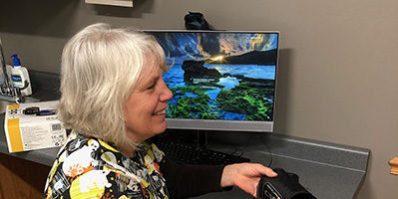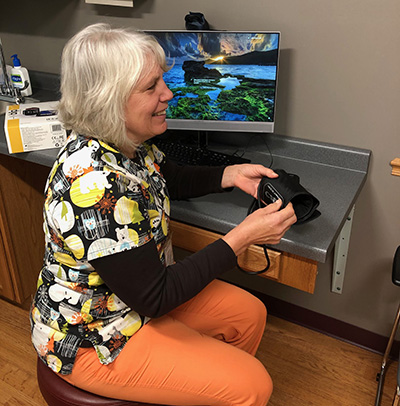Sue Maki loves taking care of others. In the 80s she moved to Iron River to care for her aging parents. She also serves as a volunteer driver and always looks for ways to help friends and neighbors.
But in the midst of helping others, Sue put her own health on the back burner. During a routine medical check-up at NorthLakes Community Clinic in Iron River she was told she needed to do a better job managing her hypertension, also known as high blood pressure.
“Doing any sort of self-care has always been a struggle for me,” explains Maki. “I wasn’t aware that my blood pressure was an issue and it was during this time that I realized I needed to start paying attention to my own health.”
Treating hypertension is not always easy. To do so, Sue needed help getting her blood pressure under control. In addition to lifestyle changes, blood pressure management can include starting or changing medications and using a blood pressure cuff for ongoing monitoring. It also can mean multiple appointments which would impact Sue’s volunteer commitments.
As she learned about the work she’d need to do to get healthy, Sue found a solution at NorthLakes Community Clinic. The At-home Blood Pressure Monitoring program uses technology to help participants manage their hypertension at home.
Participants in the program receive a free at-home blood pressure cuff that can connect to Wi-Fi. For those without Wi-Fi, participants receive a jetpack, or portable hot spot. Participants take their blood pressure twice daily at about the same time. Readings are automatically sent to a registered nurse at NorthLakes Community Clinic.
“We know that coming into the clinic for blood pressure checks can result in unnaturally high readings if you are anxious or stressed,” says Gayle Gonsior, RN. “By monitoring home blood pressure readings over a week or two, we can identify patterns which help us verify that a patient does have hypertension and then modify medications or make alterations as needed.”
Readings are shared with the patient’s provider and other members of their health care team and a treatment plan is made or modified. From there, the registered nurse contacts the participant with the plan. This process can occur several times over the course of several weeks until a participant’s blood pressure readings are stable and within normal range. This back and forth communication provides a unique opportunity that is a win-win for participants and their medical team.
“It helps the patient and it allows us to build a strong relationship with them,” Gonsior says. “I find myself having other conversations with participants who are taking a proactive approach to their health and calling me with other health questions. I can also use this opportunity to remind participants about other health checkups, such as mammograms, that might be coming due. It is just one more opportunity to build a better partnership with our patients.”
For Sue, the At-home Blood Pressure Monitoring program was exactly what she needed to get back on track. And, it was just one more example of why she appreciates having access to NorthLakes Community Clinic.
“I’ve had the opportunity to use a multitude of services at NorthLakes. I have never received such personalized care. My providers take time to talk to me and I’ve never felt rushed. It feels good to have a team that takes time to listen and treat me as a whole person.”
Looking ahead, Sue says this experience combined with excellent care has given her a renewed sense of purpose and commitment to taking care of herself, in addition to caring for those she loves.
“I am so grateful to have a team on my side working together to help me get healthier,” she says. “It made me realize that I need to have a dog in this fight and care as much about my health as this team seems to care about me.”
The At-Home Blood Pressure Monitoring program is available to patients at NorthLakes Community Clinic sites that offer primary medical services–Ashland, Hayward, Iron River, Lakewood, Minong, and White Lake. If you are interested in learning more about the program, please ask your primary medical care provider.








